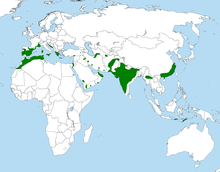| Bonelli's eagle | |
|---|---|

| |
| An adult Bonelli's eagle perched in Spain | |
| Scientific classification | |
| Domain: | Eukaryota |
| Kingdom: | Animalia |
| Phylum: | Chordata |
| Class: | Aves |
| Order: | Accipitriformes |
| Family: | Accipitridae |
| Genus: | Aquila |
| Species: | A. fasciata
|
| Binomial name | |
| Aquila fasciata Vieillot, 1822
| |
| Subspecies[2] | |
| |

| |
| Distribution of A. fasciata | |
| Synonyms | |
| |
Bonelli's eagle (Aquila fasciata) is a large bird of prey. The common name of the bird commemorates the Italian ornithologist and collector Franco Andrea Bonelli. Bonelli is credited with gathering the type specimen, most likely from an exploration of Sardinia.[3][4] Some antiquated texts also refer to this species as the crestless hawk-eagle.[5] Like all eagles, Bonelli's eagle belongs to the family Accipitridae. Its feathered legs marked it as member of the Aquilinae or booted eagle subfamily.[6] This species breeds from Southern Europe, Africa on the montane perimeter of the Sahara Desert, and across the Indian Subcontinent to Indonesia. In Eurasia, this species may be found as far west as Portugal and as far east as southeastern China and Thailand. It is usually a resident breeder.[1][6] Bonelli's eagle is often found in hilly or mountainous habitats, with rocky walls or crags, from sea level to 1,500 m (4,900 ft). Habitats are often open to wooded land and can occur in arid to semi-moist climate.[1] This eagle, though it can be considered partially opportunistic, is something of a specialist predator of certain birds and mammals, especially rabbits, galliforms and pigeons.[7] On evidence, when staple prey populations decline or are locally scarce, Bonelli's eagle switch to being an opportunistic predator of a wide variety of birds.[8] Despite its persistence over a large range and its continued classification as a least concern species by the IUCN, Bonelli's eagle has declined precipitously in various parts of its range, including almost all of its European distribution, and may face potential local extinction. The species' declines are due to widespread habitat destruction, electrocution from electricity pylons as well as persistent persecution.[9][10]
- ^ a b c BirdLife International (2019). "Aquila fasciata". IUCN Red List of Threatened Species. 2019: e.T22696076A155464015. doi:10.2305/IUCN.UK.2019-3.RLTS.T22696076A155464015.en. Retrieved 12 November 2021.
- ^ IOC World Bird List 10.2 (Report). World Bird Names. 2020. doi:10.14344/ioc.ml.10.2.
- ^ Beolens, Bo; Watkins, Michael (2003). Whose Bird? Men and Women Commemorated in the Common Names of Birds. London: Christopher Helm. p. 59. ISBN 978-0713666472.
- ^ Aimassi, G. (2015). The original description of Bonelli's Eagle Aquila fasciata Vieillot (Aves: Accipitridae). Zoological Bibliography, 4(1), 1-15.
- ^ Jerdon, T. C. (1862). The birds of India (Vol. 1).
- ^ a b Ferguson-Lees, J.; Christie, D. (2001). Raptors of the World. Houghton Mifflin Harcourt. ISBN 0-618-12762-3.
- ^ Ontiveros, Diego; Pleguezuelos, Juan M.; Caro, Jesús (May 2005). "Prey density, prey detectability and food habits: the case of Bonelli's eagle and the conservation measures". Biological Conservation. 123 (1): 19–25. Bibcode:2005BCons.123...19O. doi:10.1016/j.biocon.2004.10.004.
- ^ Moleón, Marcos; Sánchez-Zapata, José A.; Gil-Sánchez, José M.; Ballesteros-Duperón, Elena; Barea-Azcón, José M.; Virgós, Emilio (March 2012). "Predator–prey relationships in a Mediterranean vertebrate system: Bonelli's eagles, rabbits and partridges". Oecologia. 168 (3): 679–689. Bibcode:2012Oecol.168..679M. doi:10.1007/s00442-011-2134-6. ISSN 0029-8549. PMID 21947548. S2CID 253983716.
- ^ López-López, Pascual; Sarà, Maurizio; Di Vittorio, Massimiliano (2012-05-25). Bohrer, Gil (ed.). "Living on the Edge: Assessing the Extinction Risk of Critically Endangered Bonelli's Eagle in Italy". PLOS ONE. 7 (5): e37862. Bibcode:2012PLoSO...737862L. doi:10.1371/journal.pone.0037862. ISSN 1932-6203. PMC 3360590. PMID 22662239.
- ^ Sanchez-Alonso, C. & Real J. 2005. [Bonelli's Eagle in a state of emergency]. Garcilla, 122: 6-9.
